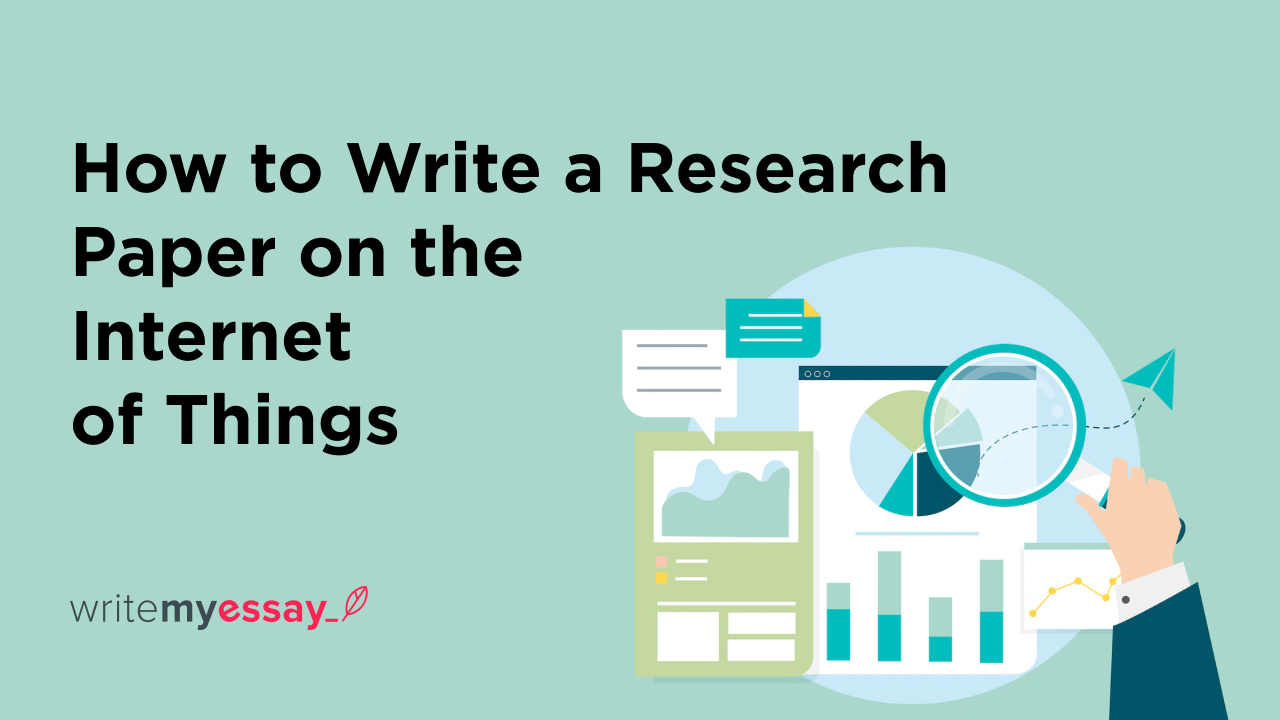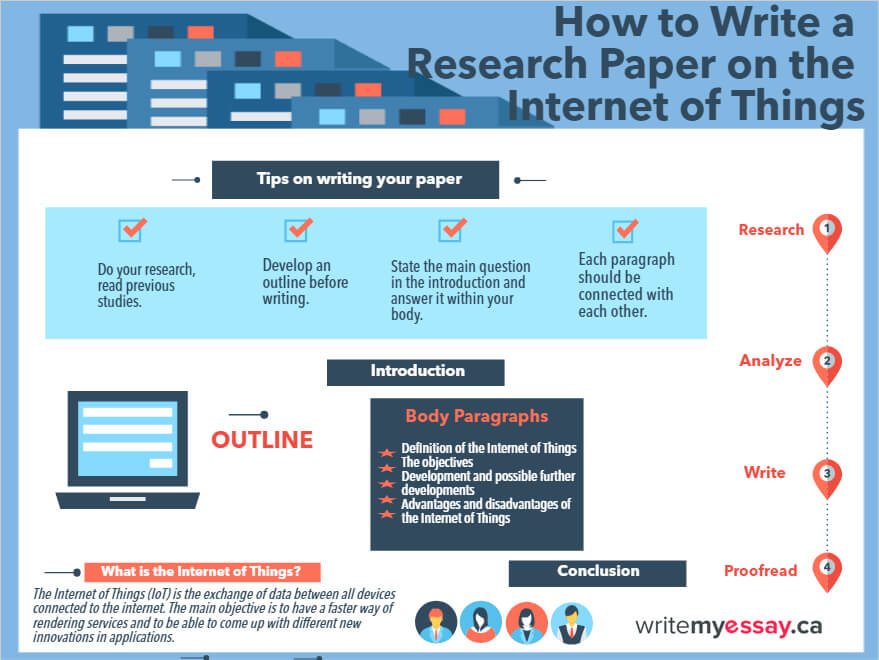
How to Write a Research Paper on the Internet of Things

Table of Contents
Internet of Things Research Paper
- How to start
- Internet of Things: Outline sample
- How to write the introduction
- Composing the thesis statement
- Thesis statement example
- Introduction example
- Body paragraphs writing
- Body paragraphs example
- Ending and concluding
- Example of the conclusion
- Research paper revision
The Internet of Things is a very timely topic to discuss. As defined, the Internet of Things is the exchange of data between all devices connected to the Internet. The main objective of the Internet of Things (IoT) is to have a faster way of rendering services and to be able to come up with different new innovations in applications.
In general, the Internet of Things is a very broad topic. It has a lot of areas and branches you can possibly choose to discuss within your research work; so, choosing a specific topic is a good thing to keep in mind since it will help you to easily discuss your points and arguments.
How to start
When it comes to starting your research paper, we suggest you read previous works, studies, or essays about the Internet of Things. It is important to know the history of your topic as it will be your edge.
Creating a research outline helps you in organizing your thoughts properly. A research outline is the simplified framework of your research. It should contain the main points you are going to discuss.
Internet of Things: Outline sample
I. Introduction
II. Body
- Definition of the Internet of Things
- The objectives of the Internet of Things
- Its current and possible further developments
- Advantages and disadvantages of the Internet of Things
III. Conclusion
- Rundown of the Internet of Things
- Final explanation
How to write the introduction
An introduction is the first paragraph of your research. It serves as your welcome paragraph. Usually, an introduction contains your questions regarding the topic you have selected. It is known as well as the brief overview of your research. In writing your introduction, make sure it is simple, as much as possible avoid using words with deep meaning.
Tips for writing an introduction:
- Keep it short and simple. Having a complicated introduction might confuse your readers.
- Make it catchy. One of the goals you have in writing research is to have your readers finish reading your work.
- Be creative. Your introduction should not sound so cliché.
- Input some ideas that might trigger your reader’s curiosity.
- Earn your readers’ trust. Let your readers feel that you know what you are saying.
Composing the thesis statement
A thesis statement is defined as the simplified representation of your research work. It usually has one or two sentences, depending on how long your research paper is. A good thesis statement should give your readers an initial idea of your research. Make it focused on the arguments you will be discussing in the course of your work.
Thesis statement example
“The Internet of Things shows how our world has been developed or innovated. It serves as the starting point for an individual to create an idea for the betterment of our humankind.”
Introduction example
“In early times, data exchange is done manually. Meaning, if you are going to transfer some coded messages, the process you would need to undergo is very long and very time-consuming. You can base it on the speed of development we had before. As time succeeds, our inventors and developers thought of making it quicker, for an easier exchange of data. They have decided in using the internet as the medium for this innovation. Look where we at now. We are enjoying the idea that benefits the whole world.”
You can do better than this, this is only a sample for you to use as a basis.
Body paragraphs writing
The body of your research should be worthy. It should contain facts so your readers can learn something new. Your main goal in writing your paper‘s body is to feed your readers’ minds. Just let your thoughts flow, but make sure you are still on the right track. The things you should be discussing need to be coherent with your main point.
Tips on writing a body of the research paper:
- Make it substantial. Do not discuss unnecessary things.
- Each paragraph should be connected with each other until you discuss your main points.
- Every argument should be well explained, do not be afraid of explaining the thing. Think about helping your readers understand the research properly.
- Make sure it is organized.
- It should be simple.
Body paragraphs example
“The Internet of Things is defined as elements connected to the internet; it can be your home appliances, your mobile device, computer, sensors, software and the many more things. It is used mainly to connect and exchange sharable data. Each thing should have a unique computing and operating system. Mainly, The Internet of Things is being processed by certain computer software. Computer experts use codes to let it work properly. Any mismatch or inconsistencies on the codes used might cause for it not work properly, so experts really need to make sure of its correctness.”
“Studies have determined an increase of 31 percent in the number of devices created. To date, experts see a potential addition of capable devices for the Internet of Things by 2020. The benefit we are getting in this innovation is really helping us meet the demands of life. Everything was made so easy, no hassle. One of the benefits we are already taking advantage of is the accuracy, the speed and the improvement of the communication process. This improvement we have gotten in the field of communication helps each nation to easily connect to another nation for a more successful trades and investments.”
“In every great invention and innovation expect negative impacts too. It has been a challenge to developers to ensure security. But as time goes by, this will eventually be fixed. In using this new innovation, we should take responsibility. We should be responsible enough with our personal details to avoid being a victim of a security breach. Do not forget to always follow the simple safety precautions, it will really help.”
Ending and concluding
In ending your research, asses whether your goal in writing a research paper (which is to feed your readers’ minds) was achieved. Remember that once you have ended your research, there is no way for you to correct any incorrect information you have created.
On the other hand, in concluding your research, it should always be simple and impacting. Always leave questions in your readers’ minds to trigger their curiosity. Do not forget to summarize your main points.
Tips for ending and concluding research:
-
- Make it easily understandable.
- Answer the main question you have stated in your introduction.
- Write it straight to the point.
- This paragraph should always start with cue words like ”to sum it up,’ ‘in a nutshell,’ ‘I, therefore, conclude,’ etc.
- Leave relatable lines for you to be remembered.
Example of the conclusion
“In the modern world, the Internet of Things is the idea of a developed data exchange. It had helped and still continues in helping us make our lives easy. Without the creation of the internet, the progress we had might be so slow. Keep in mind to always use it appropriately or properly for the continuous betterment of mankind.”
Research paper revision
Revision is a must. It is probably the most difficult process you need to properly make. In making research, there is no room for improvement. Everything should seem right to your reader’s perception.
Tips for making your revision effective:
-
- Let your friend or your family member read it. Ask for their recommendations or suggestions.
- Proofread an hour or more after you write.
- Assess your own research.
- For better research, seek professional help to review it.
Tips For Writing A Research Paper on IoT
- Rely only on primary and secondary sources to collect relevant information for your research paper. This includes resources from companies and brands as well as independent research from top universities and colleges
- To save time and hassle, try to research and outline at the same time as this will not only define the context and scope of the essay for you but makes it easier to trace steps for the writing phase
- Use online tools to speed up the proofreading and editing phase. Software such as Hemingway Editor and Grammarly can save a lot of time and trouble



